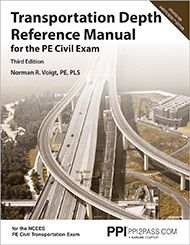Transportation Depth Reference Manual for the Civil PE Exam
Looking for an up-to-date review for the closed-book exam? Check out PPI’s new title, the PE Civil Transportation Review Manual.
Available in Print or eTextbook
Norman R. Voigt’s Transportation Depth Reference Manual for the PE Civil Exam is an excellent reference for understanding of key Transportation Engineering concepts. This guide breaks down complex engineering topics into condensed, understandable sections, making it the perfect resource to build your foundational knowledge. Key topics on the current PE Civil Transportation are covered, such as geometric design, traffic safety, and capacity analysis.
- A new code covering USAB's Proposed Accessibility Guidelines for Pedestrian Facilities in the Public Right-of-Way, 2011
- Existing code updates to reflect exam specs, including AASHTO Mechanistic-Empirical Pavement Design Guide: A Manual of Practice, 2nd Ed. and the Highway Capacity Manual, 6th Ed.
- Significant text insertion additions with significant new material about the HCM, Geometric Design, Traffic Safety, Transportation Construction, and Traffic and Capacity Analysis
- One year of access
- Ability to download the entire eTextbook to multiple devices, so you can study even without internet access
- An auto sync feature across all your devices for a seamless experience on or offline
- Unique study tools such as highlighting in six different colors to tailor your study experience
- Features like read aloud for complete hands-free review
FAQs
Some states require a BS degree from an ABET-accredited engineering program to sit for the PE exam. Other states allow you to take the PE exam with a degree in engineering technology, physics, math, or chemistry—or without any degree—as long as you’ve met the required work experience. Check your state requirements to see if you can take the PE exam without an engineering degree.
Most states allow you to take the PE exam after passing your FE exam and gaining at least four years of post-college work experience. However, some states now allow examinees to sit for the PE exam before completing their work experience. Check your state requirements to see when you’re qualified to sit for the exam.
The PE exams are not considered easy to pass, but the exam will become easier if the content reflects topics that you're familiar with from your current line of work. Think about your career goals when considering the PE exam. Are you seeking a promotion in your current role? You should select the exam that best supports your current career. Are you trying to switch industries? Choose the exam that will set you up for success in your new field. Rather than seek out the easiest PE exam, select the one that will support your goals.
